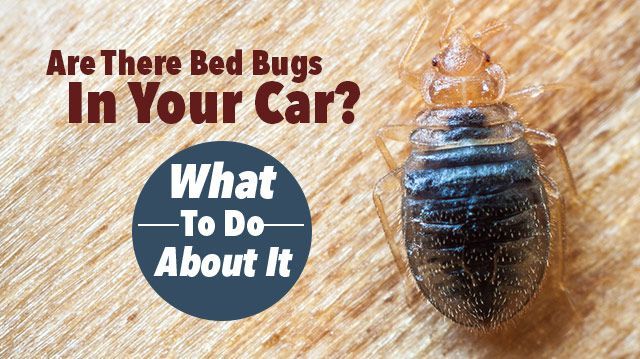
If you’ve ever dealt with bed bugs, you probably already have shivers running down your spine at the very thought. Who wants to have insects crawling through their sheets — and biting them — while they’re sleeping?
When we hear the term “bed bugs,” we often think, logically, of beds. However, these insects, part of the Cimicidae family, can live virtually anywhere. They’re small, they’re parasitic and they can travel from place to place on your clothes or luggage.
I’m not trying to gross you out, but if you’ve been noticing bites or red itchy spots on your skin after driving, chances are bed bugs have made their way into your car. Before you set your car on fire and go hunting for a new one (kidding!), you’ll be happy to know that they’re not too difficult to remove.
The inspection
Before you break out the cleaning supplies, make sure your car actually has bed bugs. For a thorough inspection, clean any clutter out of your car first. Recycle the trash, and wash any clothes and coats that are inside.
Now see if you can find any brown or burnt-orange spots, smears of blood or any sign of the small, brown bugs themselves. These are the most common signs of bed bugs. Be sure to check your console, seat corners and floors, along with your glove box, since bed bugs like to hide in cracks and folds.
Since the bed bugs had to travel to your car from somewhere, you may also want to check your home and office. In his YouTube series, “Ask the Exterminator,” Rick Steinau recommends checking for bed bugs in a bedroom by placing double-sided tape layered over painter’s tape around the edge of your mattress, under doors and on any sills or ledges at night.
In the morning, check the tape with a magnifying glass to see if any bed bugs, or traces of them, have stuck. This method can also work on office ledges, near floor mats, et cetera. Simply apply the tape before you leave for the day and bring a magnifying glass with you in the morning.
If you find you have bed bugs in your car — or in your home or office — it’s time to clean.
Clean your car
Your first step is to remove seat covers, rugs and any other removable fabrics from your car and give them a good wash with a natural detergent. Put them through a hot dry cycle after they’re done in the washer.
If you have rugs or fabrics that can’t be put in the dryer, place them in hot, direct sunlight to dry, if possible.
Next, get a bag of diatomaceous earth from your local hardware store and sprinkle it in all crevices in your car — in seat folds, all over the floor and into any other crack and corner you can find. This natural substance dehydrates insects and kills them and is safe for people and pets, unlike many chemical treatments.
If you have another source of transportation, let the diatomaceous earth sit in your car for a few days for best results. If not, go straight to the vacuuming, but keep in mind that you may need to repeat this treatment a few times to get all bugs and eggs out of your vehicle.
For vacuuming your car, choose a powerful vacuum with a HEPA filter. Make sure it has a handheld attachment for those corners and crevices. There are vacuums on the market specifically for bed bug problems, so if you have a bit of money to spend, one of these might be a good investment.
If there is a lot of dirt and bed bug material in the upholstery of your car, another good option is to steam clean. Choose a cleaner that emits high-pressure steam at 200 degrees Fahrenheit or higher. Once the interior has dried, make sure to thoroughly vacuum your car.
To keep bed bugs from infesting your car, clean it on a regular basis and keep it clutter-free.
Clean your home, office and luggage
If your car has been infested with bed bugs, they must have come from somewhere. As they can travel on clothes and luggage, make sure to give those a full cleaning. If you check your home and office with the bed bug inspection methods described above and find the critters lurking, it’s time to clean those areas, too.
Steam cleaning, vacuuming and sprinkling diatomaceous earth are the way to go. Be sure to wash and dry any fabrics around the area. If a mattress or a desk chair is the culprit, it may be time to consider replacing these.
If you’ve got a serious infestation that won’t subside no matter what you try, it may be time to call a professional bug service that is willing to use natural methods as opposed to dangerous pesticides. It may take a bit of searching, but if you search the internet or ask around businesses in your community, you’ll find something.
The good news is bed bugs aren’t known to spread disease. However, a 2014 study performed by the University of Pennsylvania found that these bugs may potentially be able to spread the parasite that leads to Chagas disease, a serious condition. So it’s worth it to the health of your entire family to nix your bed bug problem as quickly and thoroughly as possible.
—Tanya Rakhmilevich
Tanya is a writer at The Alternative Daily with a passion for meditation, music, poetry, and overall creative and active living. She has a special interest in exploring traditional Eastern remedies and superfoods from around the globe, and enjoys spending time immersed in nature.
Sources:
http://bedbugtreatmentsite.com/effectively-get-rid-bed-bugs-car
http://bedbugtreatmentsite.com/bed-bug-detection
https://dengarden.com/pest-control/6-Effective-Treatments-to-Get-Bed-Bugs-Out-of-Your-Car
http://www.uphs.upenn.edu/news/news_releases/2014/11/levy

